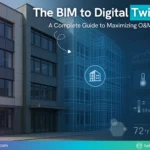Benefits of BIM: Empowering Sustainability in the AEC Industry
August 11, 2023

In an era marked by growing environmental concerns and a pressing need for sustainable development, the Architecture, Engineering, and Construction industry (AEC) has found a transformative ally in Building Information Modeling (BIM). BIM has revolutionized how we design, construct, and manage buildings, offering a digital framework that fosters collaboration, communication, and efficiency. As sustainability takes center stage in the construction sector, BIM integration emerges as a powerful solution to drive environmentally responsible practices and create a greener future.
In this blog post, we will explore the multitude of benefits BIM integration brings, from enhancing energy efficiency and reducing waste to promoting sustainable site planning and supporting life cycle assessment. By harnessing the potential of BIM for sustainability, we can pave the way for an eco-friendlier and more resilient built environment, benefiting both present and future generations.
1. Advancing Collaboration and Communication for Sustainability:
Building Information Modeling (BIM) is a dynamic hub for fostering enhanced collaboration and seamless communication within sustainability-driven initiatives. By converging architects, engineers, contractors, and facility managers onto a unified platform, BIM eradicates the conventional barriers that hamper effective cooperation in the construction domain. Consolidating project data within this shared digital ecosystem empowers team members to engage in streamlined interactions, exchange valuable insights, and engender well-informed choices.
When it comes to sustainability, working together is crucial. BIM makes it easy by uniting different experts with their own skills. Sustainable design and construction cover many aspects, like saving energy, choosing materials wisely, managing water, and picking the correct location. BIM helps blend all these parts, making sure sustainable plans are seamlessly integrated from start to finish.
2. Energy Efficiency and Performance Analysis:
BIM empowers project teams to conduct energy analysis and simulations during the design phase. By inputting data such as building orientation, envelope properties, HVAC systems, and lighting, BIM tools can predict a building’s energy performance accurately.
This analysis allows stakeholders to evaluate design alternatives and energy-saving strategies before construction begins. As a result, architects and engineers can make informed decisions to optimize the building’s energy performance and reduce its carbon footprint. BIM enables identifying energy-efficient solutions that may not be apparent in traditional 2D drawings, leading to greener and more sustainable building designs.
3. Waste Reduction and Material Efficiency:
Construction and demolition waste significantly impacts the environment. BIM helps tackle this issue by promoting waste reduction and efficient material usage. With BIM’s precise quantity take-offs and material tracking capabilities, project teams can accurately estimate the materials needed for construction.
By avoiding over-ordering materials, construction waste is minimized, saving costs, and reducing the environmental impact. Moreover, BIM can facilitate using sustainable materials and construction methodologies, further promoting eco-friendly building practices. The optimization of material usage through BIM contributes to a more resource-efficient construction process, aligning with sustainable construction goals.
4. Life Cycle Assessment and Maintenance:
Sustainability goes beyond the construction phase; it encompasses the entire life cycle of a building. BIM enables life cycle assessment, which evaluates a building’s environmental impacts from construction to operation and eventual decommissioning.
Stakeholders can make informed decisions about the building’s sustainable performance by considering maintenance requirements, energy consumption, and end-of-life considerations. This information becomes invaluable for facility managers, who can use the BIM model to plan for ongoing maintenance, optimize building operations, and ensure the long-term sustainability of the facility.
5. Sustainable Site Planning and Design:
BIM’s 3D modeling capabilities aid in sustainable site planning and design. Architects and planners can analyze site orientation, solar exposure, and green space integration to maximize energy efficiency and minimize environmental disturbances.
Project teams can explore design alternatives through BIM simulations and assess their impact on the surrounding environment. Sustainable site planning, enabled by BIM, results in buildings that harmonize with their surroundings and reduce their environmental footprint.
6. Streamlined LEED Certification Process:
LEED, which stands for Leadership in Energy and Environmental Design, is one of the most widely recognized green building certification programs worldwide. Developed and administered by the U.S. Green Building Council (USGBC), LEED provides a framework for designing, constructing, and operating environmentally sustainable buildings. The certification system evaluates a building’s performance across several categories, such as sustainable site development, energy efficiency, water efficiency, materials and resources, indoor environmental quality, and innovation in design.
By leveraging the capabilities of BIM, project teams can streamline LEED documentation and verification processes, improving the overall efficiency and effectiveness of the certification journey. BIM’s data-driven approach and visualization tools empower stakeholders to make informed decisions that contribute to achieving higher levels of LEED certification and, more importantly, creating environmentally responsible and sustainable buildings.
As the world confronts pressing environmental challenges, integrating BIM for sustainability is imperative for the AEC industry. The adoption of BIM unleashes many benefits, from enhanced collaboration and communication to improved energy efficiency and waste reduction. By leveraging BIM’s capabilities for environmentally conscious design, material optimization, and life cycle assessment, stakeholders can contribute to a more sustainable and resilient built environment. Embracing BIM integration benefits individual projects and represents a crucial step towards a greener and more sustainable future for generations to come.















